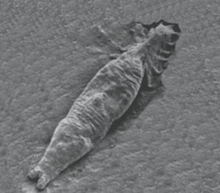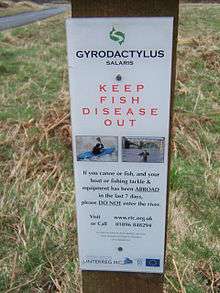Gyrodactylus salaris
| Gyrodactylus salaris | |
|---|---|
 | |
| Scientific classification | |
| Kingdom: | Animalia |
| Phylum: | Platyhelminthes |
| Class: | Monogenea |
| Order: | Monopisthocotylea |
| Family: | Gyrodactylidae |
| Genus: | Gyrodactylus |
| Species: | G. salaris |
| Binomial name | |
| Gyrodactylus salaris Malmberg, 1957 | |

Gyrodactylus salaris is a small monogenean ectoparasite (about 0.5 mm long) which mainly lives on the skin of freshwater fish, especially Atlantic salmon. This species is a leech-like parasite that has been implicated in some diminution of Atlantic salmon populations in the Norwegian fjords.[1] Its common name is salmon fluke.[2] Other species that can be parasitized include rainbow trout, Arctic char, North American brook trout, grayling, North American lake trout and brown trout.[3]
The parasite attaches to the fish by a large specialized posterior attachment organ, the haptor which has sixteen sharp hooks located around its margin. The parasite cannot be seen with the naked eye, but it can be seen with a hand held lens.[4] When feeding, the parasite attaches its anterior end to the fish with cephalic glands. It everts its pharynx through the mouth and releases a digestive solution with proteolytic enzymes which dissolves the salmon skin. Mucus and dissolved skin are then sucked into the gut. Attachment of many parasites can cause large wounds and the epidermis of the host fish can be damaged which allows secondary infections. The parasites give birth to live young nearly as big as themselves and at this time, a further generation is already growing inside the neonates.[3]
Catastrophic losses of Atlantic salmon occurred in Norway in the 1970s following the introduction of G. salaris. By 2001, the salmon populations of 41 Norwegian rivers had been virtually wiped out in this way.[3]
The parasite cannot survive in the high salinity of sea water, so the infection is not spread by the migration of fish.[2][3] Historically, Gyrodactylus-infected rivers have been treated with the indiscriminate pesticide/piscicide rotenone. A newer method of treatment employs dosing small volumes of aqueous aluminium and sulfuric acid into the river. A huge advantage of this method is its ability to kill the parasites without harming the hosts. This new method has shown promising results in Batnfjordelva and Lærdalselva, two rivers in Norway.
References
- ↑ C.Michael Hogan. 2011. Norwegian Sea. Encyclopedia of Earth. Eds. P.Saundry & C.J.Cleveland. National Council for Science and the Environment. Washington DC
- 1 2 Mitchin, Dan. "Gyrodactylus salaris" (PDF). DAISIE - europe-aliens.org. Retrieved 11 November 2010.
- 1 2 3 4 Gyrodactylus salaris, Scotland.gov, accessed 11 November 2010
- ↑ "Do not spread salmon parasite Gyrodactylus salaris" (PDF). Finnish Ministry of Agriculture and Forestry. Retrieved 11 November 2010.

